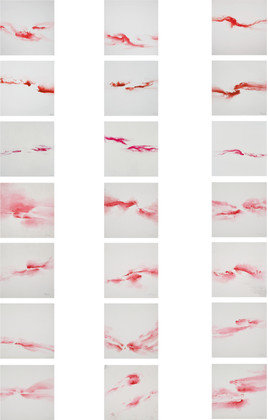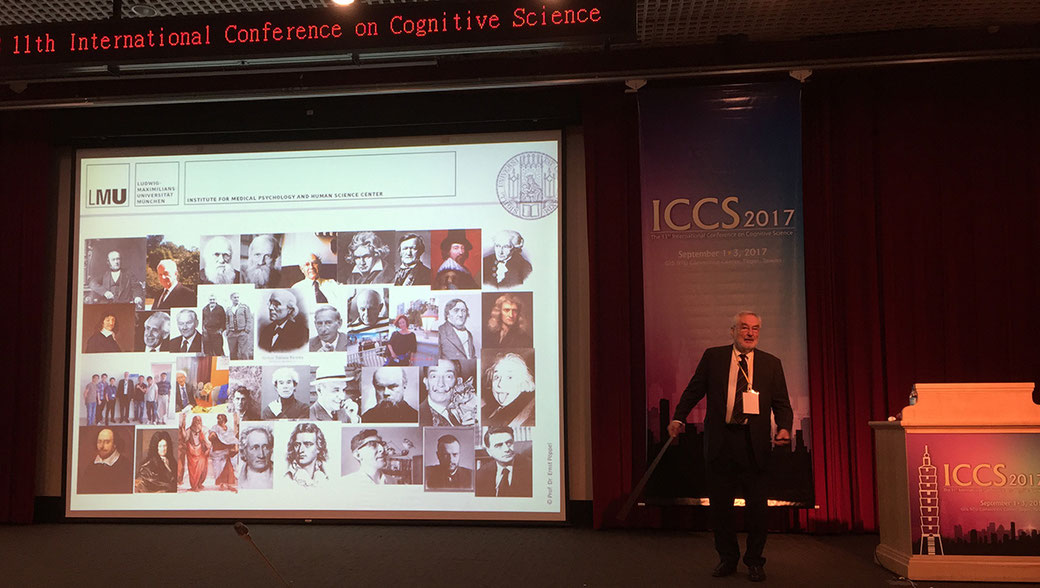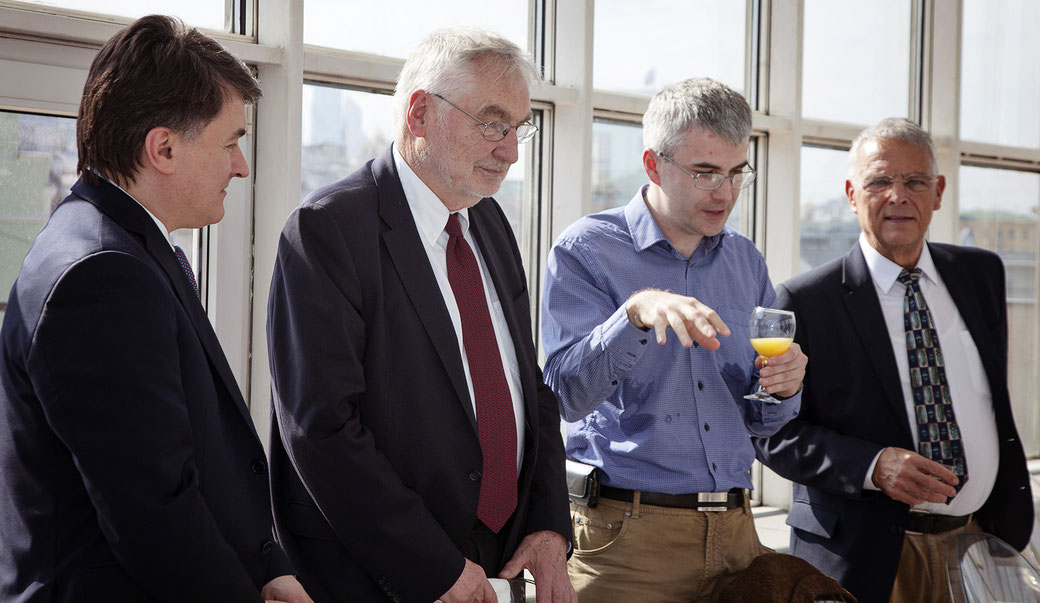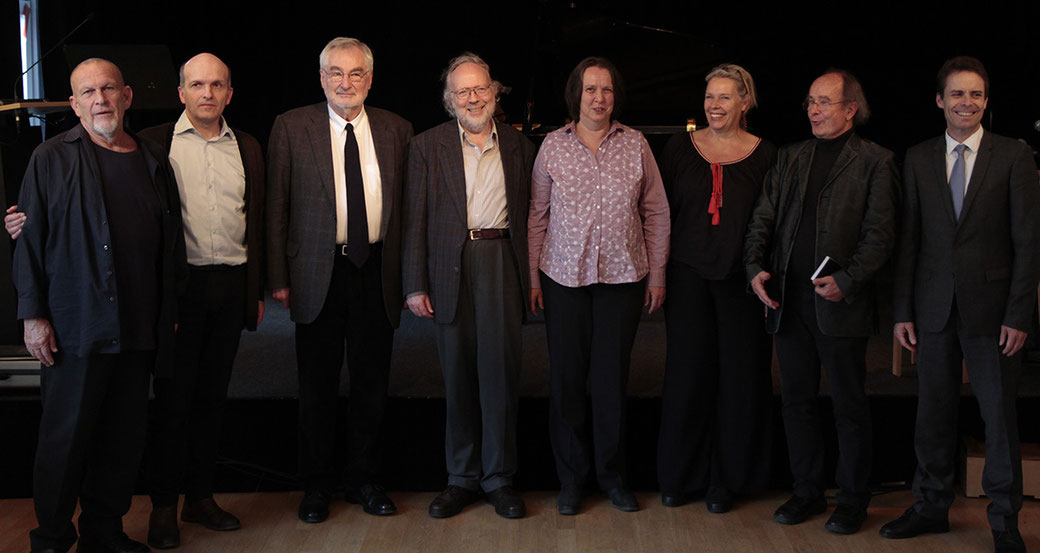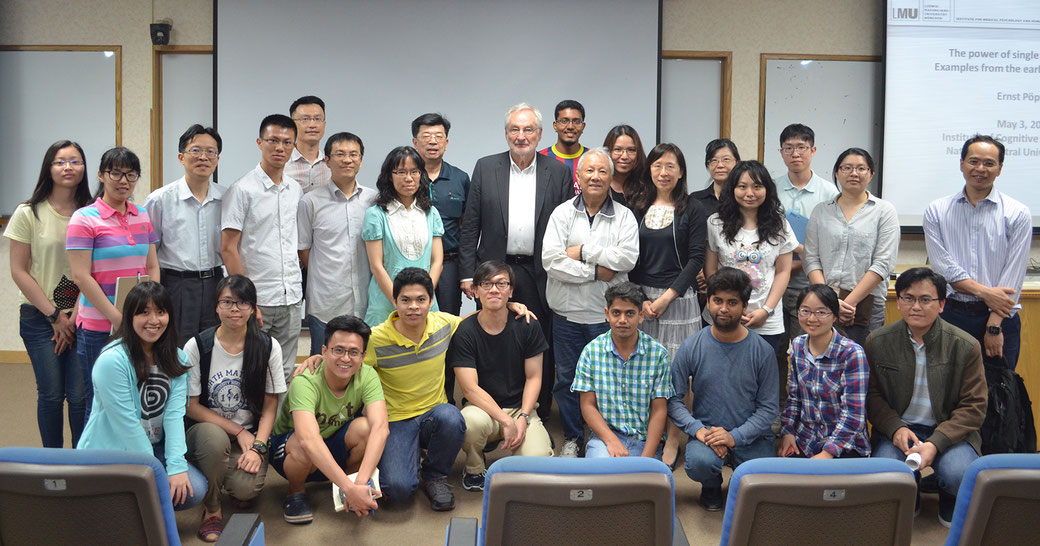Retrospection of Research and Perspectives
Ernst Pöppel (Summer 2023)
Personal examples of observations in cognitive science are sketched, and open questions, theoretical consequences and some applications derived from this research are indicated. The importance of interdisciplinarity in cognitive science is stressed. Neuropsychological and psychophysical observations on visual perception are described, and the usefulness of single case studies is emphasized. Psychophysical and neurophysiological observations indicate discrete temporal processing as reflected in “time windows” in the sub- and supra-second domain. For neural and behavioural oscillations (or oscillations in general) a statistical tool is suggested. In a taxonomy of functions the distinction between content functions and logistic functions in cognition and their complementarity in subjective representation is outlined. For these personal research domains references are given at the end. These differently looking domains share a common conceptual frame with respect to content, methodology and theoretical considerations.
Personal Spaces from a Scientific Perspective
August 2022

This is a personal report. I will make myself an "experimental subject" in this report who had personal experiences in different "social spaces".
In this journey I raise some scientific issues. The overriding motto is "scientists are natural ambassadors".
It is us, who also carry the load of peace in the world.
My journey begins on a farm where I was born, although personal history goes back almost 400 years.
The original plan in life was to raise horses and to be responsible for a farm, but that plan could not be fulfilled because of external reasons; the second world war changed everything in the original life trajectory.
The smell of horses still gives me the feeling of being at home. The olfactory system is fundamental for our memories. When returning 30 years later my first social space was recognized by the smell.
Another event relevant for neural processing: An injury on the right hand at an early age made me a left-hander in sports, although not in writing or playing golf. The plasticity of the brain during early development is amazing. We enter the world with genetic programs of possibilities like becoming a right-handed person, but early learning can re-program such neural programs.

With no ground under the feet any more becoming a refugee an attempt was made with water under the feet. This project in the navy did not work out, but the experiences on the sailing ship Gorch Fock, a very special social space, are unforgettable.
Being high up in the tackle and to see during clear weather that the earth is indeed a globe is overwhelming. Such experiences give trust in science that theoretical considerations can represent reality. In fact, already Parmenides 2500 years ago knew that the earth is a globe.

The real scientific journey started in the Max-Planck-Institute of Behavioral Physiology in Seewiesen and Erling-Andechs, Germany. An important person for me in this social space was Konrad Lorenz, one of the founders of modern ethology, the discoverer of "imprinting", who actually was once professor in Königsberg, or Kaliningrad now. With Lorenz I learned about anthropological universals, or innate releasing patterns, i.e. behavioral patterns that unite all humans, in a complementary way to cultural specifics. What makes us different, what unites us?
Unfortunately, I never met Erich von Holst. His concept of the reafference principle is central for our work today. For whatever we do, we have a copy in our brain which is meant to be matched by external information. We regularly visit his graveyard for his memory.
Besides being a great scientists he also was building violins and violas. He is, thus, also an example of a researcher bringing art and science together.


The other person in this social space was Jürgen Aschoff, who discovered circadian rhythms in humans. It was shown that the 24-hour rhythm is self-sustained when subjects spent weeks in complete isolation. This "internal clock" has become an important topic in cognitive science. We can use the 24-hour rhythm as an experimental tool. Yan Bao from Peking University has discovered that we have a morning system which is different from the evening system when paying attention. The "phase differences" of attentional control are a crucial indicator; they indicate that we are dealing with different cognitive systems. This attentional phenomenon can be explained by distinct projection systems of the retina towards central areas of the brain. Thus, neuroanatomy helps to understand cognitive phenomena.

Now I move to the MIT (Massachuesetts Institute of Technology in Cambridge, USA). When I still was at the Max-Planck-Institute of Behavioral Physiology there came as a visitor the provost of MIT and he asked what everybody is doing. I said that I study the diurnal rhythm of time perception. He said that at MIT somebody has solved the problem already:
the diurnal rhythm of time perception is determined by the diurnal rhythm of body temperature, as predicted by chemical laws; the warmer, the faster. I said that this is wrong; he looked surprised. The phases of the maxima do not coincide; the maxima of the two functions are many hours apart. He said: do you want to come to MIT?
I said yes.
At MIT I entered a new social space of high inter-disciplinarity. The director was Hans-Lukas Teuber who got some special "imprinting" from Alexander Luria in Moscow; being now Teuber's student I suddenly became a scientific grandson of Luria.
Research at MIT was dedicated to the visual system, in particular the early visual pathway. I was lucky to discover a phenomenon which later was named "blindsight". This observation opened the eyes to different knowledge systems, i.e. in addition to explicit knowledge (usually represented in language) we have to deal also with the system of implicit or tacit knowledge.
When we navigate through the world we rely mainly on the implicit knowledge system; without consciously “seeing”, we know where we are.


The social space of MIT was characterized by another deep experience. Every Tuesday evening Walle Nauta, a leading neuroanatomists, working however in an institute of psychology, gave lectures which were attended not only by students but also professors of different faculties.
One important message sticks forever in the mind; let us call it “Nauta’s law”: Every nerve cell is not farther away from any other in the brain than 4 intermediate steps. Thus, we have an amazing inter-connectivity. How to prevent neural chaos because of this high connectivity? The answer: By inhibition between neurones. Inhibition and disinhibition are essential as for instance in attentional control.
Now I find myself in my journey between social spaces in Russia. I got to know Victor Shklovsky who has set up the "Center for Speech Pathology and Neurorehabilitation" in Moscow. This is in my view the best center in the world to deal with brain injured patients.
I had several opportunities over the years to present ideas about "blindsight" and temporal processing. This center is a unique social space of taking care of patients, also in their personal environment.

It was in the early seventies last century when I worked in the Max-Planck-Institute of Psychiatry in Munich when a visitor came from the Pawlow-Institute near St Petersburg. It was Nikita Podvigin who discovered neural oscillations in the visual pathway with periods of some 30 milliseconds.
There was only one "mistake": He published in Russian, and others did not know about it. Years later, after his publications, neural oscillations were "re-discovered" and reported in another language. Now it has become a fashion to work on oscillations in different frequency domains.
What are these oscillations good for described by Podvigin? They can serve the purpose for complexity reduction of visual input which is physically ill-defined in the temporal domain. The concept is that one period defines a system state within which the before-after relationship of sensory input is not defined; thus, temporal integration for ill-defined stimuli is made possible.
Many years ago I was visiting Kaliningrad and also Svedlogorsk (formerly Rauschen) at the Baltic Sea. At the university in Kaliningrad Vera Zabotkina organized within less than a day a lecture for me, and I was impressed that students spoke German. I suddenly was in a different social space. The German novelist Thomas Mann stayed for some time in Svedlogorsk before he moved to a house in Nidden.
Having dinner at the Baltic Sea we experienced a physical social space, the sound of the water, and an interdisciplinary social space bringing art and science together. Now Vera Zabotkina from Russia together with colleagues from China, Spain and myself from Germay have published a manuscript about a “taxonomy of cognitive functions” which is based on evolutionary principles and neuropsychological observations.
Scientists own a taxonomy in chemistry as developed by Mendelejew and Meyer, or in biology as developed by Linné and substantiated by Darwin, and now we suggest one in cognitive science.


In Moscow, I see myself in episodic memory standing in front of the picture "the black square" by Kasimir Malevich in the Tretyakov Gallery. This picture can be used to characterize the deep link between art and science. When we ask ourselves what is represented on the retina, the background of the eye, the answer is: only edges and surfaces with different brightness or color. There are no lines on the retina; lines are a theoretical construct as in Euclidian geometry. This brings me now to China. The Chinese cognitive scientist Lin Chen made a fundamental discovery about the genesis of visual percepts.
His point is that prior to a local feature analysis, the visual brain extracts topological invariants like edges, surfaces, or holes. As is normal in scientific debates, colleagues have problems with that concept and argue about it; people do not like necessarily new paradigms.
Years ago I walked along the Charles River in Cambridge (the river being another social space) with Thomas Kuhn from MIT discussing with him the concept of "scientific paradigms" in his book "the structure of scientific revolutions", a book highly recommended.
The data that Lin Chen presents are convincing, but when will they reach others? His discovery is indeed fundamental in cognitive science but beyond the border of the paradigmatic dogma.
Being in the Chinese social space now I experience and have experienced another scientific paradigm we have to deal with. It has been shown that cognitive processes are embedded in a pre-semantic time window of a few seconds.

Yan Bao, who works in the tower building (see below), has called this "the magic seconds of 3". Both behavioral data and brain imaging results indicate that perceptual processes, aesthetic evaluations and many other phenomena are embedded in a temporal window of a few seconds. What is important: this time window is not created BY the information processed, but FOR information processing in neural sytems; thus, it is pre-semantic. This time window serves the purpose to create and maintain perceptual and conceptual identity - for some time; after this time segment a new percept or concept can enter consciousness, or the previous one is confirmed.

The journey between these personal social spaces has come to an end; it has brought me from Germany to the US, to Russia, to China. Many scientific questions remain open. What remains, however, is that on the basis of personal trust and friendship we work together; in the ideal case we follow one goal which is a better understanding of the
nature within us and the nature around us, and we enhance our understanding of being embedded in a cultural environment, being part of social spaces that may be different on the surface, but they are connected below the surface. Science itself is a social space. Scientists are natural ambassadors living in this space.
International Symposium at Golfclub Beuerberg

On August 8, 2019, we had an International Symposium in the Golfclub Beuerberg. I think, and I am not alone, that this is the most beautiful golf course in Germany. But it is not only the golf course itself that attracts people, it is also the friendly social environment created by the Dr. Urs und Isolde Zondler, and not to forget the outstanding cuisine.
Both Isolde and Urs are also very much interested in the sciences, driven by curiosity and open to new developments, and they also support our research projects. I thought it would be a good idea to have a symposium at such an "unlikely place" for a scientific symposium, and it turned out to be a great success.
Members of the club and guests who usually come mainly to play golf or enjoy the food, now "enjoyed" to hear what is going on in our research environment. Each project was presented in 5 minutes only and the request was that everyone cites at the end in his or her mother tongue a short poem; some ten cultural environments were present, from East to West.
I am very grateful that we could demonstrate in this very different frame of human activities that "scientists are natural ambassadors".
At the International Symposium in Beuerberg even more talks as we have seen before were presented with a bias towards young Chinese scientists. This bias is the result of a long-lasting cooperation with Prof. Yan BAO from Peking University which turned out to be extremely successful for both sides.
Yan BAO at the International Symposium in Beuerberg
International cooperations are essential to create new insight in the world within is and the world around us. But this goes beyond science: Cultural learning gives a better understanding of the others and is the basis of mutual respect. In her presentation Yan also described her discovery abput visual attention; there are two attentional systems in our visual field when we look around: one system is close to the visual axis, in the perifoveal region, the other one is dominant in the periphery of the visual field. In the morning the center is dominant, in the evening the periphery.

Jan Vasbinder, Director of Para Limes at Nanyang Technological University


Interview @The Federation of German Scientists
Prof. Ernst Pöppel in conversation with Dr. Maria Reinisch (in german) on the question of how we humans “are wired” - about the importance of specialization, why chance is part of knowledge, how knowledge leads to respect and tolerance.
The Federation of German Scientists - VDW e.V. (VDW Website)


Early in December 2019 an "INTERNATIONAL HUMANISTIC ACADEMIC FORUM: FROM KNOWLEDGE TO ACTION" took place in Moscow under the intellectual leadership of Academician Aleksandr Chubaryan (on the right), the leading historian in Russia.
Rephrasing the general topic of the Forum "from knowledge to action" I gave a talk in the Russian Academy of Sciences with the title "From Action to Knowledge - a different perspective".
Within this Forum both Prof. Yan Bao from Peking University (to the left of Prof. Chubarian) and I gave talks at the "Russian State University of the Humanities". Prof. Yan Bao talked about "Reducing complexity of our visual world: Attention matters!" And I talked about "Temporal Processing: Challenges and Chances in Research on Cognition, and its Relevance for a Taxonomy of Functions".
This meeting which was organized by Prof. Vera Zabotkina (to my right). She is Vice-Rector for International Cooperation, and the Director of the Centre for Cognitive Programs and Technologies at the Russian State University for the Humanities. In fact, she is the driving force in Russia for the development of Cognitive Sciences bringing together Brain Science, Psychology, Linguistics, Artificial Intelligence, Anthropology, and also Philosophy.
At the occasion of the Forum she took Prof. Yan Bao and me to the Bolshoi Theater.

Prof. Nikos Logothetis is one of the leading neuroscientists of our time.
From September 16 to 20, 2019, colleagues from all over the world came together in Tübingen, Germany, to celebrate him. One of the visitors was Prof. Ann Graybiel (on the left) from MIT in Cambridge, USA, who is a recipient of the "National Medal of Science".
Nikos Logothetis was my doctoral student, and I had the honor to open the conference "mysteries of the brain".

Interview in Welt am Sonntag of March 1, 2020

In the summer 1999 a large delegation from Peking University (PKU) under the leadership of Executive Vice President Prof. CHI Huisheng (in the center) visited the Human Science Center of LMU Munich. Twenty years later, on April 2, 2019, we had a nice dinner with Prof. LUO Huan (on the left, who got her Ph.D. with David Poeppel, my son, at the University of Maryland, USA), Prof. FANG Fang (next to Prof. CHI, the Dean of the "School of Psychological and Cognitive Sciences), and Prof. BAO Yan (at the right). Since many years now I have a strong cooperation with Prof. BAO, and we publishd more than 40 scientific papers on temporal processing in the brain, spatial attention, and recently also on "neuroaesthetics". We share the supervision of many students both at PKU and LMU.

During an international Summer School 2019 some participants visited the Psychiatric Clinic of Munich University. Many famous scientists and psychiatrists worked in this clinic like Alois Alzheimer.
On the picture we see from the left: Morteza Izadifar (from Iran), WANG Wei, YANG Taoxi, YANG Haiming (from China), Garam Jeong (from Korea), Ezgi Önkü (from Turkey), and Ernst Pöppel.
To bring art and science together to a "smARTSCIENCE" is one of the great challenges and also joy in the joint work of Prof. Yan Bao (in the center) and myself. We work closely together with LaoZHU (or Prof. ZHU Qingsheng, on the right)) from Peking University who is both an art historian and an artist. He is a representative of the "third abstraction", and we did some research with his artwork; these are picture we used in our experiments, and we published our results in the "PsyCh Journal" (see below). LaoZhu got his Ph.D. degree many years ago in the university of Heidelberg in Germany. Besides his career as an artist and in academia he is also active at present as president of the "Comité international d'histoire de l'art" (CIHA) in Paris."
Yan Bao, Taoxi Yang, Jinfan Zhang, Jiyuan Zhang, Xiaoxiong Lin, Marco Paolini, Ernst Pöppel, Sarita Silveira (2017): The “Third Abstraction” of the Chinese artist LaoZhu: Neural and behavioral indicators of aesthetic appreciation. PsyCh Journal 6 (2017): 110–119 DOI: 10.1002/pchj.167

Prof. Lin CHEN, member of the Chinese Academy of Sciences, has developed a theory of visual perception that opens a new perspective of brain functions in general. Paradoxically he is sitting in my office at a recent visit below a picture showing a "brain on crutches". This is my reminder to be modest with respect to progress in brain research. To the left of this brain picture is a small aquarell which I got from Nikita Chruschtschow, the grandson of the Russian politician, when he was guest scientist. Below this picture are sitting two medical doctoral students, Jana von Trott zu Solz (left) and Areso Formuli (whose family came from Kabul in Afghanistan). To my right is Dr. Taoxi YANG, my former doctoral student, now joining Prof. Semir Zeki in the University College London, and to her right the doctoral student Nan MU funded by the Chinese Scholarship Council (CSC), and then Morteza Izadifar from Iran, another doctoral student, funded by the Hanns-Seidel-Stiftung in Bavaria.
Above Taoxi YANG hangs a picture which I got as a present from the neuroanatomist Janos Szenthagothai, who also was president of the Hungarian Academy of Sciences; this aquarell shows nerve cells in the different layers of the cortex. Above Nan MU and Morteza Izadifar we see a Chinese landscape. In recent research we studied the aesthetics of landscape paintings as documented in this publication with many authors which is typical for our work:
Taoxi Yang, Sarita Silveira, Arusu Formuli, Marco Paolini, Ernst Pöppel, Tilmann Sander, Yan Bao (2019).
Aesthetic experiences across cultures: neural correlates when viewing traditional Eastern or Western landscape paintings.
One of the big problems in medicine, in particular for the aging population, is the stroke. The best center in the world for therapy of stroke and to deal with patients and their families has been in my opinion the Center for Speech Pathology and Neurorehabilitation in Moscow which was built up by Prof. Victor Markovich Shklovsky, now some 90 years old.
The new chief physician of this outstanding center is Dr. Roman Cheremin, a psychiatrist. Prof. Shklovsky and I are good friends since some 20 years, and whenever in Moscow he gives a private seminar on the fundamental importance of language. Language makes us different; thus, therapy of language is crucial.
Here are three people from Taiwan listening with fascination behind the desk of Prof. Shklovsky: from the right Prof. Ovid Tzeng from the Academia Sinica, former minister, and world specialist in reading studies, Prof. Daisy Hung from the Taipei Medical University, and Dr. Rose Lee from the Academia Sinica.
Under the leadership of Dharma Master Hsin Tao (second row in the center, left and right two buddhistic monks) the foundation of the "University for Life and Peace" in Yangon , Myanmar, is planned. For preparation of this university a "Winter School" was held in January 2019 with students from countries East and West, and faculty members representing different fields and cultures. The academic program was developed by Prof. Michael von Brück from the Human Science Center of LMU Munich (left of Dharma Master Hsin Tao and the monk Odata Ashin).

The KHDA (Knowledge and Human Development Authorities) in Dubai is a government institution dealing with educational issues. For some ten years I serve in the "International Sounding Board" (ISB) with Vince Ferrandino from the US (left) and Martin Stanley from the UK (right). In the center is Dr. Abdulla Al Karam, the director of the KHDA, on the right side Sheikha Hind Al Mualla, and on the left side Jo Maher, responsible for strategy. This service provided the unique opportunity to learn about the Arabic and Islamic culture.

Es lohnt sich zu lesen, was über Prof. Nikos Logothetis gesagt wird, einem der führenden Hirnforscher in der Welt, dem wir alle mit seinen wissenschaftlichen Beiträgen ausserordentlich viel verdanken: Speaking of Research

Scientists are natural ambassadors" is the motto, and winter schools or summer schools are an expression of this concept.
In January 2018 a small "Winter School on Cognitive Science" was held in the Human Science Center of LMU.
The picture shows the participants in front of the institute building; they came from China, Russia, Turkey, Afghanistan, Iran, USA, Austria, Greece and Germany.
The "red" person in front is Dr. Helmut Zucker who worked together with Nikos Logothetis when Nikos was my doctoral student some 40 years ago.
To the left of Prof. Nikos Logothetis from the Max-Planck-Institute of Biological Cybernetics in Tübingen we see my long-term cooperator Prof. Yan Bao from Peking University, and behind her Prof. Martha Merrow, the Director of the Institute of Medical Psychology of LMU.

Prof. ZHANG Jianxin from the Institute of Psychology, Chinese Academy of Sciences (IPCAS), in Beijing, and Prof. Ernst PÖPPEL from the Institute of Medical Psychology and the Human Science Center, Ludwig Maximilian University in Munich, are both Editors-in-Chief of the „PsyCh Journal“, China’s premier international psychology journal.
The journal is published by WILEY and the IPCAS.
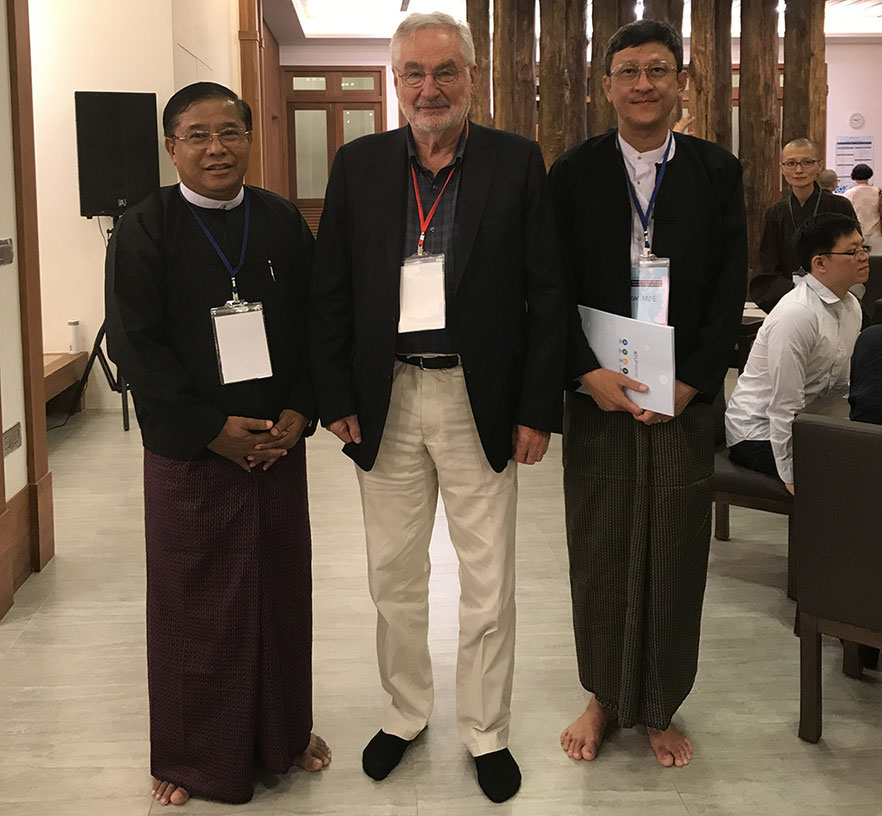
On the occasion of a „Think Tank“ in Yangon (Myanmar) to discuss the foundation of a „University of Life and Peace“.
The picture shows Ernst Pöppel with Aung Than Htut, Lt. Gen. (Ret), Parliament Member, who supports this initiative (on the left), and Director Win Moe from the Tun Htaik Tin Company.
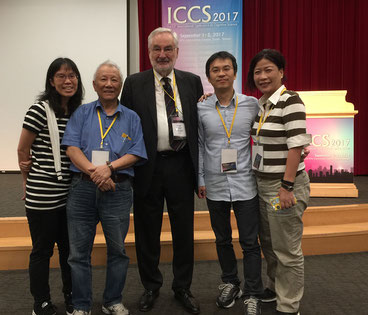
On the right side of Ernst Pöppel his Excellency Prof. Ovid Tzeng, Honorary President of the ICCS and former Minister in Taiwan, leading cognitive scientist, and a good friend.
Keynote lecture at the 11th International Conference on Cognitive Science (ICCS) September 2017 at the National Taiwanese University (NTU) in Taipei.
Title of the lecture: „Distinction between cognitive content and operative logistics in a taxonomy of functions“.
The last picture shown at the lecture expresses the gratitude we all owe to teachers, colleagues, students, as well as scientists, philosophers and artists from the past.
During the visit to the Lomonosov University Dr. Evgeny Gutyrchik, a co-worker of Ernst Pöppel, explains something with one of his typical gestures. On the right side Dr. Jan Vasbinder, director of „Para Limes“ from Nanyang Technological University (NTU) in Singapore who is supported by Ernst Pöppel in the foundation of the „Para Limes Club of Explorations“, a new initiative to develop activities beyond mainstream in art and science. To the left of Ernst Pöppel Prof. Yuri Petrovich Zinchenko, Dean of the Psychological Faculty, President of the Russian Psychological Society, Vice President of the Russian Academy of Education, and a good friend.

On top of the building of the Faculty of Psychology, Lomonosov Moscow State University at a visit in April 2017 to discuss common projects.
One the right side one has a look towards the Kremlin.

Together with Prof. Ludmilla Verbitskaya on the occasion of being elected to the „Russian Academy of Education“.
Prof. Verbitskaya is both president of the academy and president of „St. Petersburg State University“.

On the occasion of receiving on honorary doctoral degree at the Russian State University of the Humanities (RGGU) in Moscow.
To the right: The representative of the German Embassy Botschaftsrat Jan Kantorczyk.
Vice Rector of RGGU Prof. Vera Zabotkina is the representative of „Cognitive Science“ as a research area in the sciences and humanities.

Since 2007 Ernst Pöppel is member of the International Sounding Board (ISB) of the Knowledge and Human Development Authority (KHDA) of Dubai.
Recently, KHDA is trying to strengthen the academic contacts to China. At a meeting in Shanghai in Octobre 2016 Ernst Pöppel and Dr. Abdulla AlKaram, Director General of KHDA, discussed challenges of this project.
The government of Dubai provides many scholarships for Chinese students to continue their academic education in one of the branch universities in Dubai.
Since years a small group regularly comes together to study the relationship between music and science, in particuar with reference to temporal aspects in music. Several members of the group were previously associated with Sergiu Celibidache. The picture shows participants of a symposium held in “Freies Musikzentrum” Munich in Octobre 2016 on the topic “Vergleichzeitigung. Resonanzen durch Musik”. From the left: Peter Michael Hamel, Christoph Schlüren, Ernst Pöppel, Wolfgang Andreas Schulz, Christa Bützberger, Mareile Vaupel, Michael von Brück, Patrick Lang.
One of the most important presidents of Peking University was Prof. Yuanpei CAI (1863-1940), who had studied in Leipzig with Wilhelm Wundt in 1907.
His statue on the campus of Peking University is always decorated with flowers.
On the basis of his German experiences he introduced psychology as a new field at Peking University, where he was president from 1916 until 1927.
The 50th conference of the German Psychological Society was held in Leipzig to commemorate the foundation of the first laboratory of Experimental Psychology by Wilhelm Wundt in 1876; his portrait in the back. The picture shows the members of a Chinese delegation under the leadership of Prof. Shihui HAN (to my right) from Peking University.
"Unser gehirn braucht schubladen...": FOCUS-INTERVIEW
Interview im Magazin FOCUS, Ausgabe 43, vom 22. Oktober 2016. Sie können das vollständige Interview über den nebenstehenden Download-Button herunterladen.
East-West Connections: conference at NTU (Singapore)
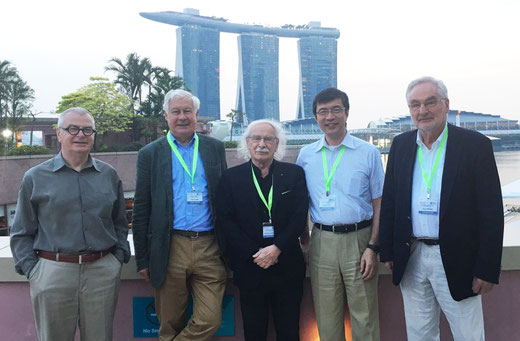
From left to right:
György Buzsaki from New York University, Guy Orban from Parma (Italy), Giacomo Rizzolatti also from Parma, Atsushi Iriki from the Riken Institute in Tokyo, and me.
The conference "East-West Connections: Grand Challenges in Brain, Cognition and Good Life Research" was held at NTU (Nanyang Technological University) and organized by Jan Vasbinder (Director of Para Limes), and Balázs Gulyás, Professor of Translational Neuroscience, LKCMedicine. Other participants were Peter Somogyi from Oxford, Tamás Freund from Budapest, Paul Matthews from London, Wolf Singer from Frankfurt, Mara Dierssen from Madrid, Fredrik Ullén from Stockholm, Jean Decety from Chicago, Torkel Klingberg from Stockholm, Stanislas Dehaene from Paris, and Henrik Ehrsson from Stockholm. More than 200 people from science, economics, politics, media, the arts in Singapore registered for the conference. The topic of my talk was: "The power of single case studies: Examples from the early visual pathway."
Symposium AT PARMENIDES FOUNDATION SEp 10

Front row (Left to right):
Xiaoxiong Lin; Prof. Yan Bao; PD Dr. Evgeny Gutyrchik; Hans Peter Michel; Tabea Matt; Susana Lara Maier; Maria Reinisch; Nan Mu; Dr. Aline Vedder.
Back row (Left to right):
Manfred Gödel; Alexander Benz; Josef Bäuml; Jana von Trott zu Solz; Tobias Batram; Prof. Ernst Pöppel; Wolfgang Grundler; Fabian Simmank; Dr. Sarita Silveira.
ICP2016 World conference of psychology ON July 24-29, 2016

Left to right:
- Prof. Yan Bao (Peking University)
- Prof. Ernst Pöppel (Ludwig-Maximilians-Universität München)
- Mr. Yasuhisa Maekawa (former European president of HONDA)
- Prof. Yoshihiro Miyake (Tojyo Institute of Technology)
Occasion:
The ICP2016 World Conference of Psychology on July 24-29, 2016 in Yokohama.
Lecture on "Single Case Studies" in Taiwan.
Why TRIPLE-P, a personal publication platform?
One of the best paper I ever published together with some colleagues had 11 reviews before it was accepted for publication. ((E. Pöppel, P. Stoerig, N. Logothetis, W. Fries, K.P. Boergen, W.
Örtel, J. Zihl: Plasticity and rigidity in the representation of the human visual field. Experimental Brain Research 68 (1987) 445-448)).
Just imagine how much time was invested: 11 reviews. ((Actually this paper never caught the attention of others.)) If I add it all up beginning with my first scientific
publication in 1967 ((actually on some statistical problems in parapsychology)), reviewers invested hundreds of hours in my work – thank you (!) -, and often wasted their time – I am
sorry(!).
Being now retired, I decided no longer to ask for temporal investments of reviewers by submitting papers to scientific journals. ((This does not imply not to co-author papers of my younger
colleagues, but certainly not in any prominent position of authorship.)) However, trying to be active also in the future and not falling into silence for the rest of my scientific life, I want to
use this TRIPLE-P to communicate some results and ideas which never were seen by a reviewer.
And TRIPLE-P serves another purpose: Some publications from the past are often hidden in books difficult to find; some of them are made accessible here, and quite a few are
written in German. ((A warning: Some of the papers are written “tongue in cheek”. Who ever heard of “igniology”?)) For practical purposes, I include also my academic cv, and I thought it might be
helpful to add a list of some earlier publications (most of them being reviewed) with short comments.


















